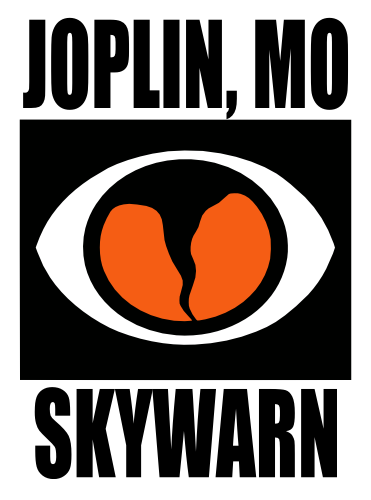This group will be establishing an operating manual for those who run net control, relay messages to the NWS, and for spotters who report conditions. In the mean time, use the following guidelines:
Spotters
You and your family’s safety comes first!
Skywarn® spotters who are ham radio operators are encouraged to check-in to net control on the 147.210 repeater during severe weather to receive information about current conditions, find out where eyes are most needed, and to relay first-hand reports back to the NWS. Net control operators are in direct communication with meteorologists at the NWS office and local Emergency Management officials. *If you are not a ham radio operator, you can still participate via other methods.
During severe weather in any of the counties covered by SGF, the Regional Skywarn out of Springfield will activate on the linked repeater system, which includes the 145.350 repeater in Joplin. This linked system covers a very wide area from Fort Scott, KS, to Joplin, Stockton, Springfield, and Rolla, MO. While reports can certainly be given directly on the 350 repeater, we will run a local net on the 147.210 to free up the linked system in case there are multiple storms in the area. Net control on the 210 will relay reports to the NWS and also relay requests for information from the NWS to spotters.
Spotters should monitor both frequencies if possible. Check in to the 210 and let the net control know where you are, if you are mobile, and the current conditions. Report severe weather including the time, location, and event. Also let them know the confidence of your report, and do not be offended if net control asks for confirmation from other spotters, especially if you are new, untrained, or if you are unsure of what you are seeing.
If you choose to be a mobile spotter, remember your first priority is your own safety. You should always use your own judgement and if net control is asking for someone to be at a certain position but the conditions you are seeing make this seem dangerous, by all means let them know and do what’s in your best interest.
Check out with net control when you have finished spotting, so they know you are no longer available as a resource.
Net Control Operation
Net Control Operators should have access to real-time weather radar such as one of the apps below, and if possible should be able to view Spotter Network positions in their app. A backup should be designated to relay to the NWS either via the NWS Chat (preferred) or the 145.350 repeater – however if a backup is not available or the net is not too busy, one person may handle both responsibilities.
A net should be initiated on the 147.210 repeater when severe weather threatens the Joplin area and areas typically to the west. Relay the current conditions and expected weather and ask for check-ins, including the station’s location and if they are mobile or fixed. The net should be run as a directed net, i.e., all communication should go through net control.
Accept all weather reports and keep a log of spotter reports, times, and positions. Pass on severe reports to the NWS and keep a line of communication open to them, there may be requests from the NWS to check for damage or ask for reports from specific locations. If the need arises, ask spotters to limit their reports to only those that meet severe criteria.
Only experienced net control operators should attempt to position spotters in the area. If there any mobile spotters that check-in, they can be directed to areas that need coverage or where they would be in the best position based on radar. Use your knowledge of storm types and radar signatures to keep them out of the severe hail and heavy rain and where they can see the area of most interest.
